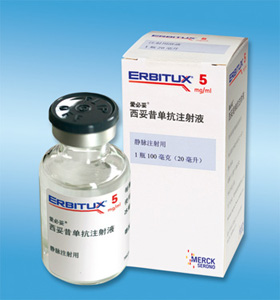西妥昔单抗(Cetuximab)中文说明书,有什么副作用?

【印度代购提示您,本品药品属性】
EGFR靶向药物嵌合型单克隆抗体
【印度代购提示您,本品药品简介】
西妥昔单抗,适应症为本品单用或与伊立替康联用于表皮生长因子受体过度表达的,对以伊立替康为基础的化疗方案耐药的,西妥昔单抗属于嵌合型IgG1单克隆抗体,西妥昔单抗分子靶点为表皮生长因子受体(EGFR)。EGFR信号途径参与控制细胞的存活,增殖、血管生成、细胞运动、细胞的入侵及转移等。
【印度代购提示您,本品药品特色】
西妥昔单抗可以以高出内源配体约5到10倍的亲和力与EGFR特异结合,西妥昔单抗可阻碍内源EGFR配体的结合。西妥昔单抗从而抑制受体的功能,西妥昔单抗进一步诱导EGFR内吞从而导致受体数量的下调。可以把靶向诱导细胞毒免疫效应细胞作用于表达EGFR的肿瘤细胞。
Cetuximab specifically binds to EGFR with an affinity approximately 5 to 10 times higher than that of endogenous ligands, and cetuximab blocks endogenous EGFR ligand binding. Cetuximab thus inhibited the function of the receptor, and Cetuximab further induced EGFR endocytosis resulting in down-regulation of the receptor number. Targeting induced cytotoxic immune effector cells can be applied to tumor cells expressing EGFR.
【印度代购提示您,本品规格】
每50ml含有西妥昔单抗100mg。
【印度代购提示您,本品用法用量】
推荐剂量:推荐初始计量为400mg/m2每体表面积,静注120分钟(最大静注速度10mg/分),每周一次。
其后每周250mg/m2每体表面积,静注60分钟(最大静注速度10mg/分),直至疾病进展或出现不能耐受毒副作用。
联合用药时,西妥西单抗需在1小时前完成静注。
【印度代购提示您,本品适应症】
西妥昔单抗与伊立替康联合用药治疗表达表皮生长因子受体(EGFR),经伊立替康联细胞毒治疗失败后的转移结直肠癌。
【印度代购提示您,本品不良反应】
西妥昔单抗耐受性好,不良反应大多可耐受,最常见的是痤疮样皮疹、疲劳、腹泻、恶心、呕吐、腹痛、发热和便秘等。
皮肤毒性反应(痤疮样皮疹、皮肤干燥、裂伤和感染等)多数可自然消失。
少数患者可能发生严重过敏反应、输液反应、败血症、肺间质疾病、肾衰、肺栓塞和脱水等。
其他不良反应还有白细胞计数下降、呼吸困难等。
【印度代购提示您,本品注意事项】
1)使用西妥昔单抗前应进行过敏试验,静脉注射西妥昔单抗20mg,并观察10分钟以上,结果呈阳性的患者慎用,但阴性结果并不能完全排除严重过敏反应的发生。
2)常可引起不同程度的皮肤毒笥反应,此类患者用药期间应注意避光。轻至中度皮肤毒笥反应无需调整剂量,发生重度皮肤毒性反应者,应酌情减量。
3)西妥昔单抗研究发现妇性患者的药物清除率较男性低25%,无需根据性别调整西妥昔单抗剂量。因能透过胎盘屏障,可能会损害胎儿或影响妇性的生育能力,故孕妇及未采取避孕措施的育龄妇女慎用。因可通过乳汁分泌,故哺乳期妇女慎用。在对儿童患者的安全性尚未得到确认前,儿童禁用。
4)严重的输液反应发生率为3%,致死率低于0.1%。抗其中90%发生于第1次使用时,以突发性气道梗阻、荨麻疹和低血压为特征。因部分输液反应发生于后续用药阶段,故应在医生监护下用药。发生轻至中度输液反应时,可减慢输液速度或服用抗组胺药物,若发生严重的输液反应需立即停止输液,静脉注射肾上腺素、糖皮质激素、抗组胺药物并给予支气管扩张剂及输氧等治疗。部分患者应禁止再次使用。此外,在使用期间如发生急性发作的肺部症状,应立即停用,查明原因,若确系肺间质疾病,则禁用并进行相应的治疗。
4) The incidence of severe infusion reaction was 3%, and the fatality rate was less than 0.1%. Ninety percent of these cases occurred at the time of first administration and were characterized by sudden airway obstruction, urticaria, and hypotension. Because some of the infusion reactions occurred during the subsequent administration, medication should be administered under the supervision of the physician. When mild to moderate infusion reaction occurs, the infusion speed can be slowed down or antihistamines should be taken. If severe infusion reaction occurs, the infusion should be stopped immediately, intravenous injection of epinephrine, glucocorticoids, antihistamines, bronchodilators and oxygen infusion should be given. Reuse should be prohibited in some patients. In addition, during the use of acute onset of pulmonary symptoms, should be immediately discontinued, to find out the cause, if it is indeed lung interstitial disease, it is prohibited and the corresponding treatment.





 咨询客服
咨询客服